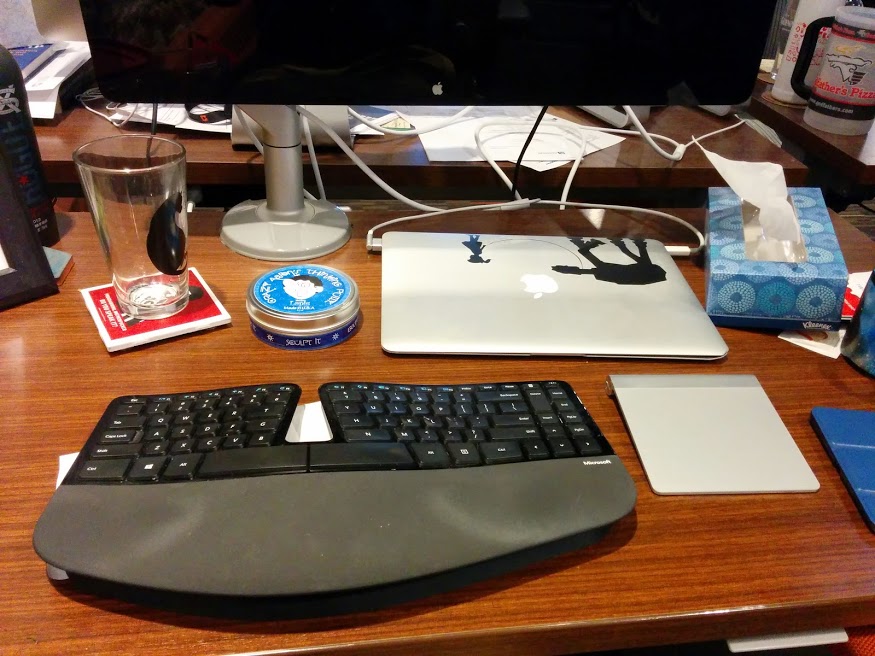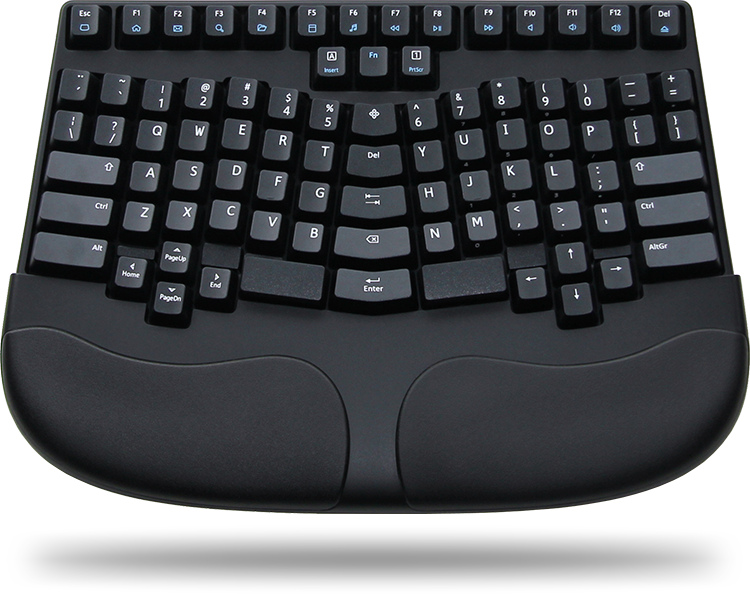Keyboards, I use them. A lot.
My quest for keyboards started about a year ago. I started getting pain in my wrists after work. As a software engineer, my wrists are very important to me. Being comfortable is very important to me. So I thought I would share with you my path to where I am today, and keep you updated along with what I’m doing.
Some History
Back when I was in high school, my dad (also a software engineer, it kinda runs in the family.) went through the same sort of thing, and he tried switching to an ergonomic and never really gave it a chance and didn’t get the hang of it, so he got rid of it. Being a high schooler, I thought it looked like the coolest thing ever. So I started using it. I used that keyboard for a number of years until I got a laptop. I quickly migrated back to a standard keyboard, since I didn’t want to lug one around and moved on with my life and forgot all about ergonomics or that I might care about them or what have you.
Fast forward to two years ago, my dad has a bunch of wrist surgery after typing a textbook on a standard keyboard. And when about a year ago I started getting pain in my wrists, I knew it was time to figure something out and fix it before I faced his fate. I went looking for my old keyboard, but it was nowhere to be found, and after searching online I found some good options. Since I was moving from an apple standard keyboard, I wanted something with chiclet keys in order to get the closest typing experience to my current setup. That pretty much left one keyboard left standing: the microsoft sculpt.
Today

After hemming and hawing, I ordered one. Having used a split before, and since I have fairly standard typing habits, I was able to pick up to my own speed relatively quickly.
Here’s what’s great about the sculpt:
- It’s small, but not too small. I have pretty big hands, and I always worry about having enough space for my fingers to spread out a bit, but I don’t like having a keyboard that fills my entire desk. At first I was worried I would miss having a number pad, but honestly I don’t. Even if I did, the sculpt comes with a detached keypad that I can use when entering lots of numbers. It mostly lives in my desk drawer.
- Split space bar. Many ergonomic keyboards, and even regular keyboards, have one spacebar tied to one key switch. With some keyboards (including the Microsoft 3000 ergonomic) hitting one side of the space bar sometimes doesn’t activate the key. Not with the sculpt though. By splitting the key in half, they’ve mostly eliminated this issue and the key activates reliably.
- Physical switch between f keys and hardware functions (like volume). I like having these convenience keys. Being able to quickly adjust volume, pause/play music or change my screen brightness is very appealing to me. At the same time, I use an IDE (Mostly intellij, but occasionally eclipse) and there are so many IDE functions that are mapped to function keys, especially in debug mode. What this means is that whenever I go into debug mode, or if I’m using a lot of IDE functions, I flip the switch on my keyboard and go at it. I don’t have to hunt for the “fn” key, and I don’t accidentally change the volume or pause a song while I’m trying to step through a code block.
- It’s comfy. It’s got a built in wrist pad, and the riser puts it at just the right hight for me. I think this is probably one of the most comfortable keyboards I’ve ever had.
- Chiclet keys. I like ‘em. I like how they press, they’re not too big, they’re a mushy mess and I like using them.
The problems I’ve had:
- The function row keys are aweful. Rather than putting more, lovely, chiclet keys up on the top row, they’ve opted for what feel like simple momentary buttons. I hate every time I have to hit the escape key. I hated it so much I rem aped it to do the escape/ctrl hybrid key. Pressing function keys is just as bad.
- It feels cheap. For a keyboard that costs ~ $90, it doesn’t look like it. At least with the apple keyboard they’ve got that nice aluminum body to them. This is made entirely of plastic. The buttons on the top row do not make the experience better.
- Sluggish. I’ve had some issues with it being quite slow to send some of the keys. When I’m typing fast, it will often miss a character here and there. This slows me down a lot, and means that there are way more errors for me to go back and fix.
- Durability. I type for almost 8 hours straight some days. Maybe not quite that much, but I do type quite a bit. Typing on this keyboard was great for the first 5 months, and then it wasn’t. I’ve got keys that don’t activate sometimes. My space bar on the right side doesn’t feel like it comes back up all the way. Instead of a slight click when I type, I get a muffled thud. Maybe it’s dirt, maybe it’s something I did. I don’t know, because if I pull the key cap off to look, I’m worried I’ll just break it.
What’s next?
After looking at what I had and what I wanted, I came to 2 realization. First, I should be on mechanical keys. I want something that I’m not worried about breaking when I type. I know, that this is the “Anti” chiclet key, but hey, if you’re going to change, go all the way. Second, I wanted something that I can easily change up the firmware on and re-arrange where some of the keys are. This is something I grew envious of when a neighbor at work showed off his HappyHacking 2.
I wanted these new features but I also wanted to keep my ergonomic layout. And that pretty much limits what your options are.
The first thing I looked at was the TruelyErgonomic keyboard. At about $250, it’s up a pretty far step from the keyboard I’m on now, but it does have all of the features I’m looking for. There are two things that concerned me.

First, their FAQ has a weird rant about the better business bureau. I thought that was pretty strange. They talk about how it’s not fair that they should be rated so poorly, and how they won’t fix it without them paying to be a member and yada yada yada. While I’m sure not wanting to pay for membership is disenfranchising them, I have to ask. How many people had to report that shady things to the BBB before that brought you to this point? Almost every single review I read where people had decided at the end to return the keyboard, many of them report that their requests for an return have been more or less ignored. Given their site’s promise of a full refund if you don’t like the keyboard after a month, I wonder how often their returns aren’t accepted.
So even though I was potentially interested in their keyboard, I was thoroughly turned off by the number of negative reviews. And the idea of sinking $250 into some weird keyboard I might not be able to return sketched me out a little too much for me to drop that kind of cash.
So I moved on.
I started looking at some of the other ergonomic keyboards out there. The only other keyboard with mechanical keys on the market I could find was the Kinesis advantage.

Given I like having a desk I decided to move on and try and find something else. That was when I started saying, well maybe I can build one? That’s when I stumbled across ErgoDox. So, that’s where I’m headed. I ordered all of the parts and they should get here this weekend. I’m working on laser cutting my own case, so I guess we’ll see how that goes and move from there.
The ErgoDox
For those of you not familiar with the ErgoDox, it is sort of the unicorn of mechanical keyboards. Nobody manufactures them, if you want one you have to either source the parts and build on yourself, or you have to wait for mass drop to do a drop with all of the parts in it, and you still have to build it yourself. Or you have to find someone who made one and doesn’t like it and convince them to give or sell it to you. Or you have to pay some poor high school a boat load of money to solder one together for you. In all of these circumstances, it can be difficult.

I’m going to be building one, but I’ll go into that next week. First I want to talk about why I chose this.
- I like how customizable it is. It literally has 100% customizable firmware. You can even checkout the source and change things up if you want, or you can use mass drop’s really nice customizer tool they host on their website.
- Thumb clusters. We have two thumbs, and they’re both quite dexterous. So why are the only on one key? I’ve heard some people say that some of the thumb cluster keys are pretty useless if you have small hands, I honestly don’t care, having more than just that one key is going to be nice.
- Totally split. I like that I can keep my hands as far apart as I want. Unlike the kinesis advantage (though similar to some of their other keyboards) or the TEK, you can put things in the middle and move around the sides independently.
- Nerd cred. I work in an environment where there are some pretty weird keyboards. From my friend who’s go the HappyHacking 2, to another guy who’s got an old apple serial keyboard on a usb adapter. Having a unique keyboard gives me a warm fuzzy feeling inside.
- Projects. I like projects, so having a project that benefits me at work is pretty appealing. Plus, I get to design cool things on the case.
- Cost. By sourcing my own parts and making the case, I’ve got the cost down to ~$150, I’m harvesting some old keycaps from my dad’s defunct das keyboard, and building the case from some scrap hobby plywood I’ve got around the garage (and can laser cut at my local maker space).
I should get the parts this weekend, so I guess I’ll see how it goes!
